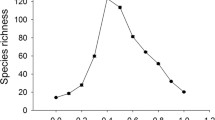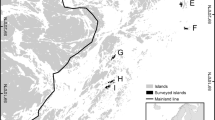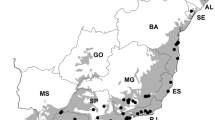Abstract
Ecological theory predicts a positive influence of local-, landscape-, and regional-scale spatial environmental heterogeneity on local species richness. Therefore, knowing how heterogeneity measured at a variety of scales relates to local species richness has important implications for conservation of biological diversity. We took a statistical modeling approach to determine which metrics of heterogeneity measured at which scales were useful predictors of local species richness, and whether the heterogeneity-local richness relationship was always positive. Local plant species richness data came from 400-m2 vegetation plots in North and South Carolina, USA. At each of four scales from within plots to across regions, we used either GIS or field data to calculate measures of heterogeneity from abiotic environmental variables, vegetation productivity data, and land cover classifications. Among all predictors at all scales, we found that no measure of heterogeneity was a better predictor of local richness than mean pH within plots. However, at scales larger than within plots, measures of heterogeneity were correlated most strongly with local richness, and each of the three classes of variables we used had a distinct scale at which it performed better than the others. These results highlight the fact that ecological processes occurring across multiple scales influence local species richness differently. In addition, relationships between heterogeneity and richness were usually, though not always, positive, underscoring the importance of processes that occur at a variety of scales to local biodiversity conservation and management.




Similar content being viewed by others
References
Belyea LR, Lancaster J (1999) Assembly rules within a contingent ecology. Oikos 86:402–416
Brown JH, Kodric-Brown A (1977) Turnover rates in insular biogeography: effect of immigration on extinction. Ecology 58:445–449
Burnham KP, Anderson DR (2002) Model selection and multi-model inference: a practical information-theoretic approach. Springer-Verlag, New York
Chesson P (2000) General theory of competitive coexistence in spatially-varying environments. Theor Popul Biol 58:519–553
Christensen NL (2000) Vegetation of the southeastern coastal plain. In: Barbour MG, Billings WD (eds) North American terrestrial vegetation, 2nd edn. Cambridge University Press, Cambridge, pp 397–448
Christensen NL, Bartuska AM, Brown JH, Carpenter S, D’Antonio CM, Francis R, Franklin JF, MacMahon JA, Noss RF, Peterson CH, Turner MG, Woodmansee RG (1996) The report of the Ecological Society of America committee on the scientific basis for ecosystem management. Ecol Appl 6:665–691
Cornwell WK, Grubb PJ (2003) Regional and local patterns in plant species richness with respect to resource availability. Oikos 100:417–428
Davies KF, Chesson P, Harrison S, Inouye BD, Melbourne BA, Rice KJ (2005) Spatial heterogeneity explains the scale dependence of the native-exotic diversity relationship. Ecology 86:1602–1610
Environmental Protection Agency (2004) Level III and IV Ecoregions of EPA Region 4. U.S. Environmental Protection Agency, National Health and Environmental Effects Research Laboratory, Western Ecology Division, Corvallis. 1:2,000,000
Ewers RM, Didham RK, Wratten SD, Tylianakis JM (2005) Remotely sensed landscape heterogeneity as a rapid tool for assessing local biodiversity value in a highly modified New Zealand landscape. Biodiv Conserv 14:1469–1485
Frost CC (2006) History and future of the longleaf pine ecosystem. In: Jose S, Jokela E, Miller D (eds) Longleaf pine ecosystems: ecology, management, and restoration. Springer, New York, pp 9–48
Gelman A, Hill J (2007) Data analysis using regression and multilevel/hierarchical models. Cambridge University Press, Cambridge
Gelman A, Su Y, Yajima M, Hill J, Pittau MG, Kerman J, Zheng T (2009) Arm: data analysis using regression and multilevel/hierarchical models. R package version 1.2-9. http://www.stat.columbia.edu/~gelman/software/
Gould WA, Walker MD (1997) Landscape-scale patterns in plant species richness along an arctic river. Can J Bot 75:1748–1765
Homer C, Huang C, Yang L, Wylie B, Coan M (2004) Development of a 2001 national land cover database for the United States. Photogramm Eng Remote Sens 70:829–840
Homer C, Dewitz J, Fry J, Coan M, Hossain N, Larson C, Herold N, McKerrow A, VanDriel JN, Wickham J (2007) Completion of the 2001 National Land Cover Database for the conterminous United States. Photogramm Eng Remote Sens 73:337–341
Hurlbert AH, Haskell JP (2003) The effect of energy and seasonality on avian species richness and community composition. Am Nat 161:83–97
Jimenez I, Distler T, Jorgensen PM (2009) Estimated plant richness pattern across northwest South America provides similar support for the species-energy and spatial heterogeneity hypotheses. Ecography 32:433–448
Kelt DA, Taper ML, Meserve PL (1995) Assessing the impact of competition on community assembly: a case study using small mammals. Ecology 76:1283–1296
Kerr JT, Packer L (1997) Habitat heterogeneity as a determinant of mammal species richness in high-energy regions. Nature 385:252–254
Kerr JT, Southwood TRE, Cihlar J (2001) Remotely sensed habitat diversity predicts butterfly richness and community similarity in Canada. Proc Natl Acad Sci 98:11365–11370
Levin SA (2000) Multiple scales and the maintenance of biodiversity. Ecosystems 3:498–506
Lundholm JT (2009) Plant species diversity and environmental heterogeneity: spatial scale and competing hypotheses. J Veg Sci 20:377–391
Lunn DJ, Thomas A, Best N, Spiegelhalter N (2000) WinBUGS—a Bayesian modelling framework: concepts, structure, and extensibility. Stat Comput 10:325–337
Mittelbach GG, Steiner CF, Scheiner SM, Gross KL, Reynolds HL, Waide RB, Willig MR, Dodson SI, Gough L (2001) What is the observed relationship between species richness and productivity? Ecology 82:2281–2396
Nagendra H (2001) Using remote sensing to assess biodiversity. Int J Remote Sens 22:2377–2400
Nagendra H (2002) Opposite trends in response for the Shannon and Simpson indices of landscape diversity. Appl Geogr 22:175–186
NASA (2008) MODIS Vegetation Indices 16-Day L3 Global 250 m [spatial data] 5.0. https://lpdaac.usgs.gov/lpdaac/get_data/data_pool. Accessed June 2008
Palmer MW, Earls PG, Hoagland BW, White PS, Wohlgemuth T (2002) Quantitative tools for perfecting species lists. Environmetrics 13:121–137
Parviainen M, Luoto M, Heikkinen RK (2009) The role of local and landscape level measures of greenness in modelling boreal plant species richness. Ecol Model 220:2690–2701
Peet RK (2006) Ecological classification of longleaf pine woodlands. In: Jose S, Jokela E, Miller D (eds) Longleaf pine ecosystems: ecology, management, and restoration. Springer, New York, pp 51–94
Peet RK, Wentworth TR, White PS (1998) A flexible, multipurpose method for recording vegetation composition and structure. Castanea 63:262–274
Pettorelli N, Vik JO, Mysterud A, Gaillard J-M, Tucker CJ, Stenseth NC (2005) Using the satellite-derived NDVI to assess ecological responses to environmental change. Trends Ecol Evol 20:503–510
Pinheiro J, Bates D, DebRoy S, Sarkar D (2009) nlme: linear and nonlinear mixed effects models. R package version 3.1-92
Pulliam HR (1988) Sources, sinks, and population regulation. Am Nat 132:652–661
R Development Core Team (2009) R: a language and environment for statistical computing. Foundation for Statistical Computing, Vienna
Reynolds HL, Mittelbach GG, Darcy-Hall TL, Houseman GR, Gross KL (2007) No effect of varying soil resource heterogeneity on plant species richness in a low fertility grassland. J Ecol 95:723–733
Ricklefs RE (1977) Environmental heterogeneity and plant species diversity: a hypothesis. Am Nat 111:376–381
Ricklefs RE (1987) Community diversity: relative roles of local and regional processes. Science 235:167–171
Riitters KH, Wickham JD, Vogelmann JE, Jones KB (2000) National land-cover pattern data. Ecology 81:604
Shmida A, Wilson M (1985) Biological determinants of species diversity. J Biogeogr 12:1–20
Simpson EH (1949) Measurement of diversity. Nature 163:688
Singer JD, Willett JB (2003) Applied longitudinal data analysis: modeling change and event occurrence. Oxford University Press, Oxford
Snyder RE, Chesson P (2004) How the spatial scales of dispersal, competition, and environmental heterogeneity interact to affect coexistence. Am Nat 164:633–650
Sorrie BA, Weakley AS (2001) Coastal plain vascular plant endemics: phytogeographic patterns. Castanea 66:50–82
Southeast Gap Analysis Project (2008) Southeast GAP Regional Land Cover [digital data]
St-Louis V, Pidgeon AM, Radeloff VC, Hawbaker TJ, Clayton MK (2006) High-resolution image texture as a predictor of bird species richness. Remote Sens Environ 105:299–312
U.S. Geological Survey [USGS] (1999) National Elevation Dataset 7.5-Minute Elevation Data
Waring RH, Coops NC, Fan W, Nightingale JM (2006) MODIS enhanced vegetation index predicts tree species richness across forested ecoregions in the contiguous U.S.A. Remote Sens Environ 103:218–226
Wood SN (2006) Generalized additive models: an introduction with R. Chapman and Hall/CRC, Boca Raton
Zuur AF, Ieno EN, Walker N (2009) Mixed effects models and extensions in ecology with R. Springer, New York
Acknowledgments
We thank Carolina Vegetation Survey personnel, past and present, for data collection and database administration. We also thank Jack Weiss for assistance with statistical analysis. This work was supported by NASA Terrestrial Ecology and Biodiversity grant #NNG06GI70G to A.M. and R.K.P.
Author information
Authors and Affiliations
Corresponding author
Electronic supplementary material
Below is the link to the electronic supplementary material.
Rights and permissions
About this article
Cite this article
Costanza, J.K., Moody, A. & Peet, R.K. Multi-scale environmental heterogeneity as a predictor of plant species richness. Landscape Ecol 26, 851–864 (2011). https://doi.org/10.1007/s10980-011-9613-3
Received:
Accepted:
Published:
Issue Date:
DOI: https://doi.org/10.1007/s10980-011-9613-3




